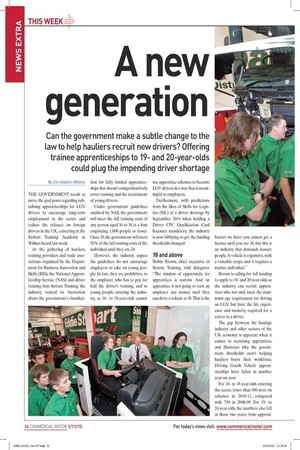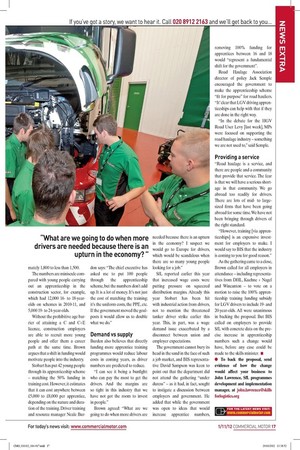A new generation
Page 11

Page 12

If you've noticed an error in this article please click here to report it so we can fix it.
Can the government make a subtle change to the law to help hauliers recruit new drivers? Offering trainee apprenticeships to 19and 20-year-olds could plug the impending driver shortage
By Christopher Walton
THE GOVERNMENT needs to move the goal posts regarding subsidising apprenticeships for LGV drivers to encourage long-term employment in the sector and reduce the reliance on foreign drivers in the UK, a meeting at the Stobart Training Academy in Widnes heard last week.
At the gathering of hauliers, training providers and trade associations organised by the Department for Business, Innovation and Skills (BIS), the National Apprenticeship Service (NAS) and driver training firm System Training, the industry vented its frustration about the government’s classifica tion for fully funded apprenticeships that doesn’t comprehensively cover training and the recruitment of young drivers.
Under government guidelines outlined by NAS, the government will meet the full training costs of any person aged 16 to 18 at a firm employing 1,000 people or fewer. Once 19, the government will meet 50% of the full training costs of the individual until they are 24.
However, the industry argues the guidelines do not encourage employers to take on young people. In fact, they are prohibitive to the employer, who has to pay for half the driver’s training, and to young people entering the industry, as 16to 18-year-olds cannot use apprentice schemes to become LGV drivers in a way that is meaningful to employers.
Furthermore, with predictions from the likes of Skills for Logistics (SfL) of a driver shortage by September 2014 when holding a Driver CPC Qualification Card becomes mandatory, the industry is now lobbying to get the funding thresholds changed.
18 and above
Robin Brown, chief executive of System Training, told delegates: “The window of opportunity for apprentices is narrow. And an apprentice is not going to earn an employer any money until they can drive a vehicle at 18. That is the barrier we have: you cannot get a licence until you are 18, but this is an industry that demands mature people. A vehicle is expensive, with a valuable cargo, and it requires a mature individual.” Brown is calling for full funding to apply to 19and 20-year-olds so the industry can recruit apprentices who not only meet the minimum age requirement for driving an LGV, but have the life experience and maturity required for a career as a driver.
The gap between the haulage industry and other sectors of the UK economy is apparent when it comes to recruiting apprentices, and illustrates why the government thresholds aren’t helping hauliers boost their workforce. Driving Goods Vehicle apprenticeships have fallen in number year-on-year.
For 16to 18-year-olds entering the sector, fewer than 500 were on schemes in 2010-11, compared with 750 in 2008-09. For 19to 24-year-olds, the numbers also fell in those two years: from approxi mately 1,800 to less than 1,500.
The numbers are miniscule compared with young people carrying out an apprenticeship in the construction sector, for example, which had 12,000 16to 18-yearolds on schemes in 2010-11, and 5,000 19to 24-year-olds.
Without the prohibitive age barrier of attaining a C and C+E licence, construction employers are able to recruit more young people and offer them a career path at the same time. Brown argues that a shift in funding would motivate people into the industry.
Stobart has put 42 young people through its apprenticeship scheme – matching the 50% funding in training cost. However, it estimates that it can cost anywhere between £5,000 to £8,000 per apprentice, depending on the nature and duration of the training. Driver training and resource manager Neale Bur don says: “The chief executive has asked me to put 100 people through the apprenticeship scheme, but the numbers don’t add up. It is a lot of money. It’s not just the cost of matching the training; it’s the uniform costs, the PPE, etc. If the government moved the goalposts it would allow us to double what we do.”
Demand vs supply
Burden also believes that directly funding more apprentice training programmes would reduce labour costs in coming years, as driver numbers are predicted to reduce.
“I can see it being a bunfight: who can pay the most to get the drivers. And the margins are so tight in this industry that we have not got the room to invest in people.” Brown agreed: “What are we going to do when more drivers are needed because there is an upturn in the economy? I suspect we would go to Europe for drivers, which would be scandalous when there are so many young people looking for a job.” SfL reported earlier this year that increased wage costs were putting pressure on squeezed distribution margins. Already this year Stobart has been hit with industrial action from drivers, not to mention the threatened tanker driver strike earlier this year. This, in part, was a wage demand issue exacerbated by a disconnect between union and employer expectations.
The government cannot bury its head in the sand in the face of such a job market, and BIS representative David Sampson was keen to point out that the department did not attend the gathering “under duress” – as it had, in fact, sought to instigate a discussion between employers and government. He added that while the government was open to ideas that would increase apprentice numbers, removing 100% funding for apprentices between 16 and 18 would “represent a fundamental shift for the government” .
Road Haulage Association director of policy Jack Semple encouraged the government to make the apprenticeship scheme “fit for purpose” for road hauliers. “It’ clear that LGV driving apprenticeships can help with that if they are done in the right way.
“In the debate for the HGV Road User Levy [last week], MPs were focused on supporting the road haulage industry – something we are not used to,” said Semple.
Providing a service
“Road haulage is a service, and there are people and a community that provide that service. The fear is that we will have a serious shortage in that community. We go abroad too readily for drivers. There are lots of midto largesized firms that have been going abroad for some time. We have not been bringing through drivers of the right standard.
“However, training [via apprenticeships] is an expensive investment for employers to make. I would say to BIS that the industry is coming to you for good reason.” As the gathering came to a close, Brown called for all employers in attendance – including representatives from DHL, Kuehne + Nagel and Wincanton – to vote on a motion to raise the 100% apprenticeship training funding subsidy for LGV drivers to include 19and 20-year-olds. All were unanimous in backing the proposal. But BIS called on employers to provide SfL with concrete data on the precise increase in apprenticeship numbers such a change would have, before any case could be made to the skills minister. ■ ● To back the proposal, send evidence of how the change would affect your business to John Lawrence, SfL programmes development and implementation manager, at john.lawrence@skills forlogistics.org











































